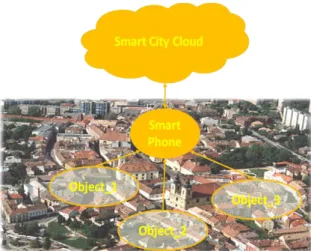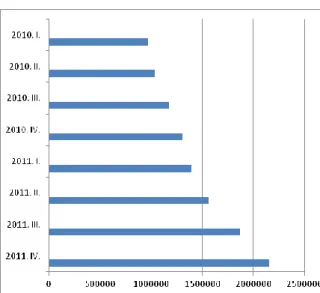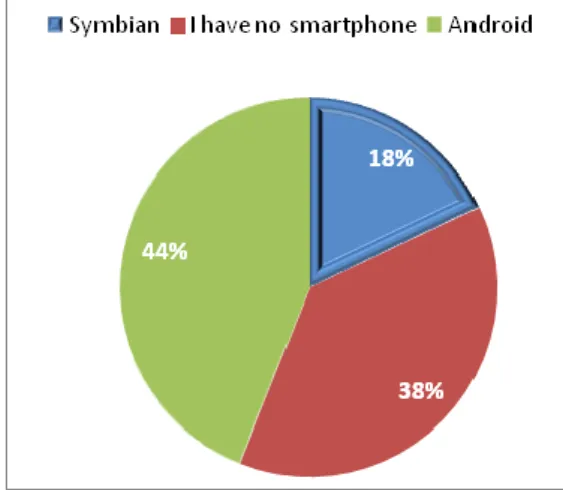Figure 1. Smart city cloud and smart phone communication
Local Implementation of Smart City Concept
M. Seebauer and K. Kolozsvári
Óbuda University, Alba Regia University Center, Székesfehérvár, Hungary seebauer.marta@arek.uni-obuda.hu
kolozsvari.krisztian@hok.uni-obuda.hu Abstract—The aim of Smart City project is to build a well
livable environment by creating an innovative network for e-services between the city’s facilities, government, citizens, guests and other partners. The present paper describes the benefits of the Smart City project and the way of their further development.
I. INTRODUCTION
The Smart City program is a perfect fit for the European Union FP7 Framework Programme for Research and Technological Development. The existence of this program is a very important milestone in itself and within the category.
However, thanks to the enlightened thinking those are more and more efforts in the information society and politics. It is of particularly appropriate importance to manage the development and evaluate on of this aspect of innovation. Information, production, distribution, dissemination, use and manage are significant economic, political and cultural activities in the information society.
A. The FP7 Framework Program
A related concept of it is knowledge economy, in the sense that the value is created through economic exploitation. FP7 supports with the aim of research in selected priority areas of the EU in the areas where then want to win an keep a leading position. [1]
FP7 is made up of four main business groups in four specific programs plus a fifth specific program on nuclear research form. For this, the project's feasibility, the most important cooperation programs and within the ICT (Information and Communication Technologies) Society expressed by these demands shows the importance of the fact that in the FP7 budget "cooperation" makes up the largest proportion. This budget is EUR 32,365 million and in the cooperation program budget the Information and communication technologies' budget of EUR 91,110 million occupies a significant proportion.
B. The Horizon 2020 Program
The new program of EU for research and innovation Horizon 2020 will run from 2014 to 2020 and provides a budget of €80 billion. The main purpose of this program is to create new growth and jobs in Europe. [2]
In the focus of Horizon 2020 are the research and innovation provided through the Framework Programmes for Research and Technical Development, the innovation related activities of the Competitiveness and Innovation Framework Programme and the European Institute of Innovation and Technology. The dedicated for science budget is EUR 24,598 million and EUR 17,938 million for innovation.
II. THE SMART CITY CONCEPT
The smart city is a settlement which is available for technology, especially information and communication opportunities for innovative ways of using and promoting a better, more diversified and more sustainable urban environment.
A city can be described as intelligent if economic growth in human capital, as well as traditional and modern information and communication infrastructure to encourage investment by allowing increased living standards and the judicious management of natural resources. [3]
The different ICT applications running in Smart City Cloud grant a break out potential for new dimension of life, management and discovery of city. Thanks to the new smart technology the city is much more efficient in improving the living conditions of citizens. [4]
The smart technology provides an enormous progress in all days life not only for the local people but for visitors, too. Using smart phones opens a new horizon also in the tourist services by offering intelligent applications navigating through the touristic sights and giving up-to- date information about the facilities, hotels and restaurants.
III. THE INTELLIGENT TOURISTIC PROJECT The general aim of Intelligent Touristic Project is to develop an application offering the ideal sightseeing route using a program customized to the visitor’s demand. The program is based on the tourist information system and can positive effect on the customer services of smart city.
Figure 2. Smart phone holders by gender
Figure 3. . Gender distribution in smart phone buying
Figure 4. Number of mobile Internet subscription in Hungary Three effects of the system are extremely important.
The first one is the overall image of the city.
Székesfehérvár was the medieval capital of Hungary and a a large number of tourist visits the town every year. It is very important the feeling of safety a personally care during the visit.
The second important factor is the boost of the economy. As a tourist arrives the city, in a defined period of time want to visit the selected sights. An optimal route offers not only spiritual food but the best catering and shopping facilities. If he is satisfied than the city has added revenue.
The third and most important benefits of the project is for further care of the environment. If tourists is supplied with electronic information, the paper consumption will be decreased through the less need on submitted brochures, booklets and other printed materials.
For the realization of project from the visitor’s side two technical condition are required, smart phone and mobile Internet subscription. This is the reason of the described below statistical research.
IV. THE SMART PHONE AN MOBIL INTERNET MARKET The NRC survey of recent market research shows that the number of smart phone users in the first quarter of 2012 from increased 26% to 34% pro year. [5] This survey deals with the spread of smart phones to other devices. The research data reveal that the smart phone spread inversely proportional decrease in the traditional mobile phone users, the number, and those devices whose location can take over this one unit, so the music player, digital camera and GPS sales show decreasing trend, while the people's comfort level is constantly increasing.
The result of public opinion research suggests that among 18 and 49 year old regular Internet users 37% have a smart phone. The questionnaire is defined as an operating system capable of running applications online, and full touch-screen keyboard containing mobile phone.
The research [6] shows that the number of smart phone users was significantly higher in men than in women.
(Fig.2.) Another survey carried out by the Research Centre 28 percent of the population who do not have a smart phone, plan to buy within six months based on.
Among the potential buyer of smart phones the number of women is increasing. (Fig.3.)
In addition, smart phone use varies linearly with the level of education, so there are more users hava college or university graduates from the group than the low-educated group members.
It is also important to note the economically active user show higher use. The majority of smart phone users have mobile access to the Internet, but also on non-mobile devices. In Hungary, the most common Internet activities are visiting social networking sites, news sites and e-mail inquiry to the one that most likely will be transferred from the users of mobile devices.
Fig.4. presents the number of mobile internet subscriptions in Hungary [7]. This is the rate of growth.
While in 2010 969,940 subscribers in the first quarter, the fourth quarter of 2011 that number increased to 2,154,842 subscribers. That is more than double of the growth rates.
V. MARKET SHARE OF LEADING SMART PHONE OPERATING SYSTEMS
From the beginning of rapid penetration of smart phones and mobile Internet the main question for the software developer was the selection of perspective operating system and programming platform. The statistic presents a very interesting of two most significant open source platforms Android and Symbian. (Fig. 5.)
Symbian was the leading mobile operating system until 2010. More than 10 years of history, it is already optimized for mobile. The native C++ language, any other programming languages were implemented for it. The market share is rapid decreasing in the last years, in moment only 6%.
The BlackBerry's market share is very low, below 6%.
Especially popular in America, has been on the market since 2002. Most of the popular business phone business,
Figure 5. Global market share of leading smart phone operating systems in sales [8]
Figure 6. Market share of smart phone operating systems worldwide in 2012 and 2016 [9]
effective networking services. Mainly in Java development environment can be achieved.
iOS has 20,5% market share now. It is very convenient for easy-to-use multi-touch solutions. It was appeared on the market in 2007. There is in App Store a very rich collection of applications available.
Windows Phone expanded the Windows desktop experiences for the target representation. In October 2012, due to the release of Windows Phone 8 more handset manufacturers, HTC, Nokia and Samsung have made a serious product range.
Android is a very popular Linux-based mobile software technology. It is not a operating system, but an open source application framework. Development is relatively simple using Java programming language. The first release was published in 2008, and now a the lot of mostly free Android Market applications are available for Android users. The survey found that Android has a 61%
market share now and has a rapi growing character.
For a long time, the Symbian was the leading smart phone platform in which leadership has been unable to take any other system. Even the entry of Apple's mobile has not threatened to defeat. But this situation has now changed.
Google's Android operating system is designed to not only catch up with Symbian, but the last quarter of last year, it also allowed him to rich the top. The jump to the first place by Android itself is not surprising, analysts have long expressed this to happen, but the growth rate and the speed is amazing. According to the predictions Fig.6. the Android platform will keep the fixed leadership until the year 2016. ( Fig.6.)
VI. LOCAL IMPLEMENTATION
The global research results supported by evidence that the development of smart touristic project for Székesfehérvár should be carried out first on Android platform.
A poll was carried out about the local peopl’s opinion from the smart touristic program. One issue was that it would work if the application with smart phones in the city, attempting to city dwellers, and they consider useful to the program. The results are illustrated in the Fig.7..
The diagram presents that 72% of citizens fund it for a good idea, and also would use the application. Thus, the development team has confirmed that the concept is necessary and useful.
Figure 8. Dispersion of smart phone’s platforms in Székesfehérvár
Figure 7. Opinion of Székesfehérvár’s citizens about the smart touristic program
A further 23% who do not has a smart phone considers it also a good idea and supports the implementation of the program. Only 5% of those in urban areas do not see any of the five options listed. But what is most important that
the city's management team sees a great potential in this and supports the development and implementation of the program after the completion of the urban tourism.
Another question related to mobile platforms. The result presented in Fig 8.
38% of the respondents do not have smart phone. In the present research distinguished from the global research the Android platform get only 44% and the second most popular was the Symbian platform by 18%.
VII. CONCLUSIONS
Overall, the research was successful. Based on the results the team decided to start development of the first version of the program in Android platform. And the second version will the Windows mobile platform, while the global statistics gave them a good prognosis. The legitimacy of the idea was verified.
REFERENCES
[1] http://ec.europa.eu/research/participants/portal/page/fp7_documen tation Retrieved October 28, 2012
[2] http://ec.europa.eu/research/horizon2020/index_en.cfm?pg=h2020 Retrieved October 28, 2012
[3] Smarter cities for Smarter Growth, IBM Institute for Business Value, 2010,. IBM Global Services Route 100, Somers, NY 10589, U.S.A.
[4] http://intelligensvarosok.kormany.hu/index/eu-smart-city-program Retrieved October 28, 2012
[5] http://www.itbusiness.hu/Fooldal/hirek/piackutatas_n/okostelefon _hodito.html Retrieved October 28, 2012
[6] http://www.netkutatasok.hu/ Retrieved October 28, 2012 [7] http://www.ksh.hu/docs/hun/xftp/gyor/tav/tav21112.pdf Retrieved
October 28, 2012
[8] http://www.statista.com/statistics/73662/quarterly-worldwide- smartphone-market-share-by-operating-system-since-2009/
October 28, 2012
[9] http://www.statista.com/statistics/182363/marketshare-forecast-of- smartphone-operating-systems/ October 28, 2012


![Figure 5. Global market share of leading smart phone operating systems in sales [8]](https://thumb-eu.123doks.com/thumbv2/9dokorg/1147668.82238/3.893.147.752.117.376/figure-global-market-share-leading-smart-operating-systems.webp)
